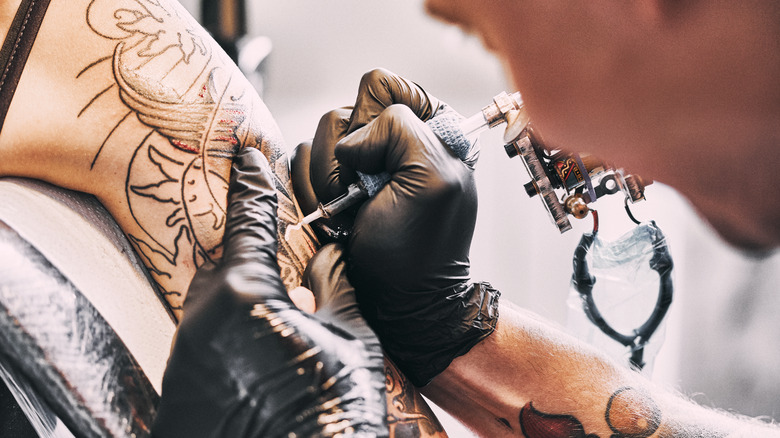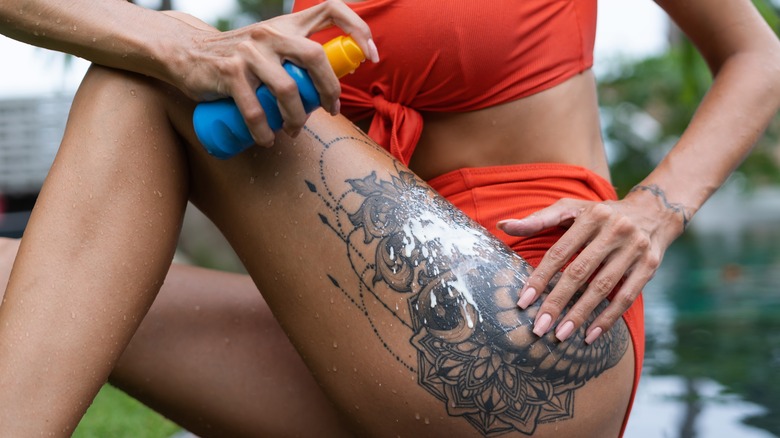Brand-New Tattoo This Summer? You Might Want To Put Swimming On Hold
As the weather heats up and clothes come off, you might be tempted to get some new ink to flaunt this summer. As it turns out, it's not as simple as going under the needle this season. If you plan on swimming the days away, you might want to pump the brakes. Tattoos are a serious commitment that require a bit of aftercare, especially in the summer months.
There are some essential factors you should consider before getting a tattoo, from researching your tattoo artist's reputation to determining the correct placement. On this pre-tat checklist, timing is perhaps the most overlooked. It's important to consider the time of year you book an appointment, especially during summer — which is the worst time of year to get a tattoo.
Complications such as sun damage, scarring, and infection are more likely to arise during the summer months. If you expect to be poolside or have a couple of beach days planned, there are some facts you might want to consider before jumping in.
How tattoo infections happen
When getting a tattoo, ink is injected into both the outer (epidermis) and middle (dermis) layers of your skin, per Medical News Today. Since ink deposited into the dermis is what makes a tattoo permanent, ink on the epidermis causes the skin to shed as the tattoo heals. The healing process can be interrupted by excessive contact with clothing, sun exposure, and water. Non-sterile water sources such as oceans, hot tubs, and pools contain billions of bacteria that can lead to infection, dermatologist Jeremy Fenton, M.D., told Byrdie.
"If you allow chemicals (such as chlorine in a pool) or other substances in the water into the healing skin, it could ultimately affect the color and cosmetic result of the tattoo such as increased fading or discoloration," Fenton said. In addition to affecting the ink's vibrance, the risk of infection is quite high as well. "After any break to the skin, the natural immune defenses are impaired, and this increases the risk of infection," dermatologist Dr. Kathleen Welsh explained to Healthline.
The main culprit for such complications is Vibrio, a bacteria that largely inhabits open bodies of water. The CDC reports that Vibrio is responsible for nearly 80,000 illnesses and 100 deaths each year in the United States. The majority of these infections come from wound exposure to warm seawater, or even from consuming raw seafood. While avoiding oceans, lakes, and rivers are best, heavily chlorinated pools still carry the risk of bacterial infections.
Healing your tattoo
So, how long to avoid diving right in? All in all, you should try to avoid swimming for the entirety of your healing process, Mayo Clinic suggests. Additionally, you should apply sunscreen and avoid direct sun exposure, as your tatted outer skin is highly sensitive during this period. But if you just can't keep away from the waves, there are a couple of workarounds. Cover your tattoo with a waterproof bandage before swimming and properly treating the tattoo after a shower can make all the difference.
Fenton advises Byrdie, "Immediately after swimming, dry the skin, remove the bandage, and gently wash the area with soap and water. You should resume your normal wound care after patting it dry." To avoid any setbacks during tattoo recovery, keep the area dressed in an antibiotic ointment. Here are some of the best unscented creams to heal your new tattoo.
As a final reminder, avoid picking at scabs. They are a normal sign of healing and may appear on the skin surrounding your tattoo after a few weeks. However, scratching at scabs can increase the risk of infection and cause scarring, which is certainly not the look you're going for.


